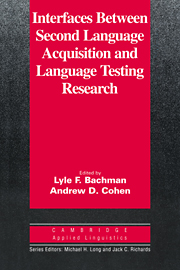Book contents
- Frontmatter
- Contents
- List of contributors
- Series editors' preface
- Preface
- Chapter 1 Language testing – SLA interfaces: An update
- Chapter 2 Construct definition and validity inquiry in SLA research
- Chapter 3 Research on interlanguage variation: Implications for language testing
- Chapter 4 Strategies and processes in test taking and SLA
- Chapter 5 Describing language development? Rating scales and SLA
- Chapter 6 Testing methods in context-based second language research
- Chapter 7 How can language testing and SLA benefit from each other? The case of discourse
- Appendix: Language testing – SLA research interfaces
- Index
Chapter 6 - Testing methods in context-based second language research
Published online by Cambridge University Press: 05 October 2012
- Frontmatter
- Contents
- List of contributors
- Series editors' preface
- Preface
- Chapter 1 Language testing – SLA interfaces: An update
- Chapter 2 Construct definition and validity inquiry in SLA research
- Chapter 3 Research on interlanguage variation: Implications for language testing
- Chapter 4 Strategies and processes in test taking and SLA
- Chapter 5 Describing language development? Rating scales and SLA
- Chapter 6 Testing methods in context-based second language research
- Chapter 7 How can language testing and SLA benefit from each other? The case of discourse
- Appendix: Language testing – SLA research interfaces
- Index
Summary
In an important paper published over a quarter of a century ago, J. B. Carroll (1968) articulated very succinctly, albeit unintentionally, the relationship between language testing (LT) and second language acquisition (SLA) research by defining a test as “a procedure designed to elicit certain behavior from which one can make inferences about certain characteristics of an individual” (p. 6). If some of the “characteristics” include the linguistic (as they do), then the link between LT and SLA is clear: A language test is an SLA elicitation device. However, it has largely been the case that language testing concerns and SLA concerns have tended to develop in their separate ways. Part of the impetus for the present volume is the recognition that SLA and LT researchers have much to say to each other, and that insights and methods from both fields (and others within applied linguistics) are mutually beneficial.
In a discussion of mutual influences between SLA research and language testing, Bachman (1989; reprinted in the Appendix, this volume) notes a growing consensus among language testing researchers that language ability consists of a number of distinct but related component abilities. This multicomponential view of language ability, Bachman suggests, raises complex issues for SLA researchers, including the effect of context of language use on the development of different components of language proficiency.
- Type
- Chapter
- Information
- Publisher: Cambridge University PressPrint publication year: 1999
- 2
- Cited by



